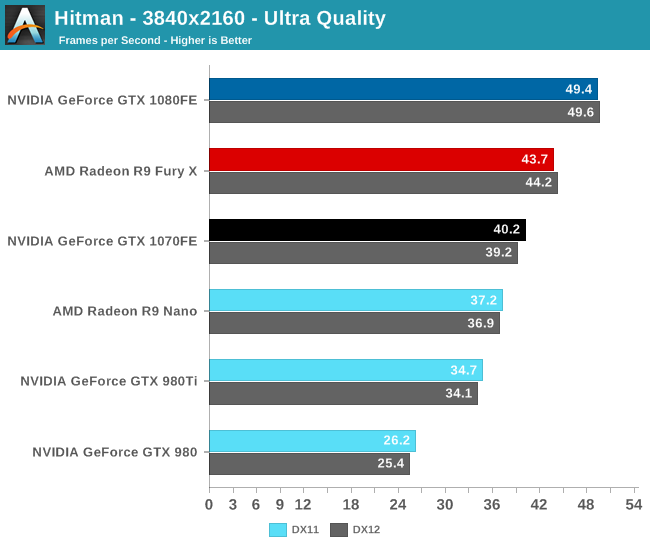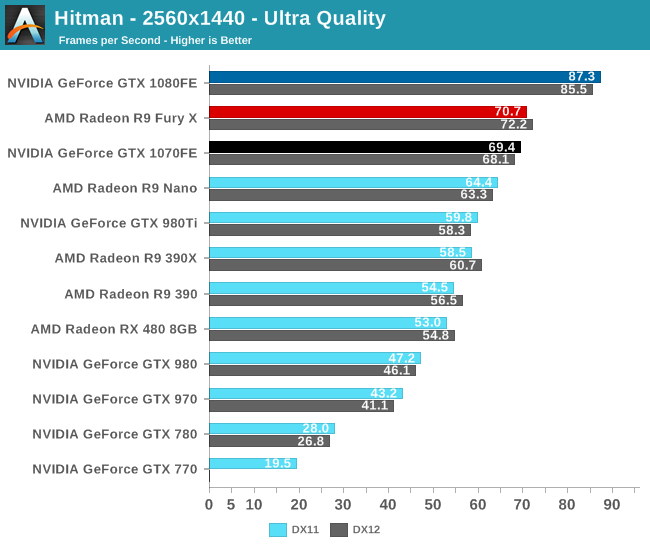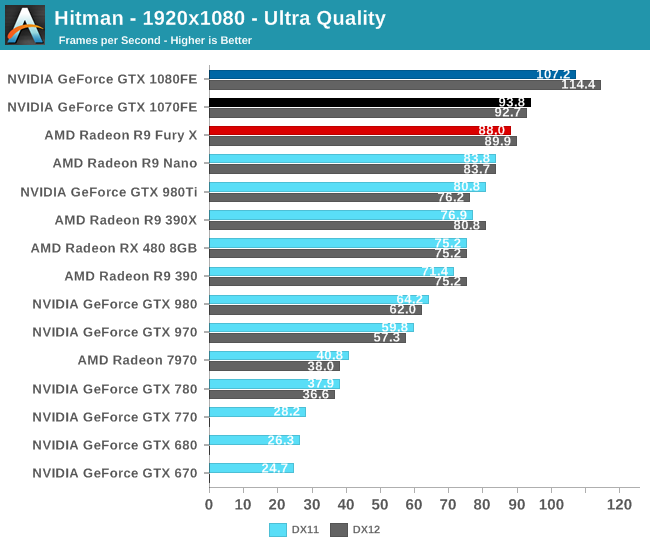The NVIDIA GeForce GTX 1080 & GTX 1070 Founders Editions Review: Kicking Off the FinFET Generation
by Ryan Smith on July 20, 2016 8:45 AM ESTHitman
The final game in our 2016 benchmark suite is the 2016 edition of Hitman, the latest title in the stealth-action franchise. The game offers two rendering paths: DirectX 11 and DirectX 12, with the latter being the case of DirectX 12 being added after the fact. As with past Hitman games, the latest proves to have a good mix of scenery and high model counts to stress modern video cards.



Because Hitman supports both DX11 and DX12, for the moment we’ve gone ahead and benchmarked it with both. In practice the performance impact of DX12 is very mixed; NVIDIA cards prior to Pascal lose performance and Pascal cards can either gain or lose performance. AMD cards on the other hand tend to gain performance. The image quality is the same with both renderers, so it’s simply a matter of picking the render path that produces the best performance for a given card.
In any case, the GTX 1080 continues to top the charts here. 60fps still isn’t attainable at 4K, but it can deliver a reasonably playable 49fps. Alternatively, at 1440p it does better than 85fps. Meanwhile the GTX 1070 isn’t a great option at 4K, but at 1440p it can easily stay north of 60fps, delivering 69.4fps.
Thanks in part to the DX12 code path, this is another game where the GTX 1070 performs as expected versus GTX 1080, but still can’t hold on to second place. Rather the Radeon Fury X takes second place at all but 1080p.
Looking at our generational comparisons one last time, this final game has the Pascal cards performing better than expected. At 1440p and above, the GTX 1080 hits 86% better performance than the GTX 980 under DirectX 11, and the GTX 1070 bests the GTX 970 by an average of 63% in the same circumstances. As best as I can tell, there is just something about the Pascal cards that is slightly more in tune with this game than was the Maxwell 2 cards, leading to the performance we’re seeing here. Otherwise the gap between the GTX 1080 and GTX 1070 is pretty typical at about 25% at the higher resolutions.
Finally, in our last time checking in on the GTX 680, the GTX 1080 offers a commanding performance improvement. GTX 1080 is 4.1x faster than GTX 680 under DirectX 11, reinforcing just how much progress NVIDIA had made in 4 years and a single full manufacturing node upgrade.










200 Comments
View All Comments
Ninhalem - Wednesday, July 20, 2016 - link
There's 32 freaking pages in this review. Maybe people have other jobs instead of writing all day long. Did you ever think of that?I'll take quality and a long publishing time over crap and rushing out the door.
Stuka87 - Wednesday, July 20, 2016 - link
Thanks for the extremely in depth review Ryan!cknobman - Wednesday, July 20, 2016 - link
I cannot help feel just a bit underwhelmed.Of course these Nvidia cards kick some major butt in games that have always favored Nvidia but I noticed that in games not specifically coded to take advantage of Nvidia and furthermore games with DX12 that these cards performance advantage is minimal at best vs an old Fury X with half the video RAM.
Then when you take into account Vulcan API and newer DX12 games (which can be found elsewhere) you see that the prices for these cards is a tad ridiculous and the performance advantage starts to melt away.
I am waiting for AMD to release their next "big gun" before I make a purchase decision.
I'm rocking a 4k monitor right now and 60fps at that resolution is my target.
nathanddrews - Wednesday, July 20, 2016 - link
1080 is close to being that 4K60 card, but can't quite cut it. I'm waiting for "Big Vega" vs 1080Ti before dropping any money.lefty2 - Wednesday, July 20, 2016 - link
Great review - one of the few that highlights the fact the Pascal async compute is only half as good as AMD's version. Async compute is a key feature for increasing performance in DX12 and Vulkan and that's going to allow the RX 480 to perform well against the GTX 1060Daniel Egger - Wednesday, July 20, 2016 - link
"... why the memory controller organization of GP104 is 8x32b instead of 4x64b like GM204"Sounds like it's the other way around.
Ryan Smith - Wednesday, July 20, 2016 - link
No, that's correct. 8 32bit wide controllers rather than 4 64bit wide controllers.http://images.anandtech.com/doci/10325/GeForce_GTX...
http://images.anandtech.com/doci/8526/GeForce_GTX_...
DominionSeraph - Wednesday, July 20, 2016 - link
>It has taken about 2 years longer than we’d normally see... for a review of a flagship card to come out
sgeocla - Wednesday, July 20, 2016 - link
The old Maxwell was so optimized it was always full and didn't even need Async Compute. The new Pascal is so much more optimized that it even has time to create the "holes" in execution (not counting the ones in your pocket) that were "missing" in the old architecture to be able to benefit for Async Compute. Expect Volta to create even more holes (with hardware support) for Async Compute to fill.tipoo - Wednesday, July 20, 2016 - link
That's demonstrably untrue.http://www.futuremark.com/pressreleases/a-closer-l...
Plenty of holes that could have been filled in Maxwell.